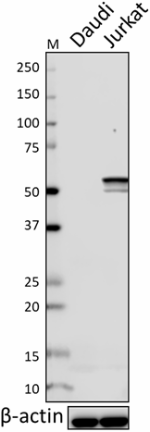- Clone
- 7H9A33 (See other available formats)
- Regulatory Status
- RUO
- Other Names
- DNA nucleotidylexotransferase (DNTT), Terminal addition enzyme, Terminal transferase
- Isotype
- Mouse IgG1, κ
- Ave. Rating
- Submit a Review
- Product Citations
- publications

-

Whole cell extracts (15 µg protein) from Daudi (negative control) and Jurkat cells were resolved on a 4-20% Tris-glycine gel, transferred to a nitrocellulose membrane and probed with 0.5 µg/mL (1:1000 dilution) of Purified anti-TdT Antibody, clone 7H9A33, overnight at 4°C. Proteins were visualized by chemiluminescence detection using HRP goat anti-mouse IgG Antibody (Cat. No. 405306) at a 1:3000 dilution. Direct-Blot™ HRP anti-β-Actin Antibody (Cat. No. 664804) was used as a loading control at a 1:25000 dilution (lower). Lane M: Molecular Weight marker. Predicted DNTT expression obtained from Human Protein Atlas.
Terminal deoxynucleotidyl transferase (TdT), also known as DNA nucleotidylexotransferase (DNTT) or terminal transferase, is a member of the DNA polymerase type-X family and encodes a template-independent DNA polymerase that catalyzes the addition of deoxynucleotides to the 3'-hydroxyl terminus of oligonucleotide primers. TdT is a specialized DNA polymerase expressed early in pre-B and pre-T lymphoid cell development, and in acute lymphoblastic leukemia/lymphoma cells. TdT contributes to the generation of junctional diversity by synthesizing non-germ line elements (N-regions) at the junctions of rearranged Ig heavy chain and T cell receptor gene segments.
Product DetailsProduct Details
- Verified Reactivity
- Human, Mouse
- Antibody Type
- Monoclonal
- Host Species
- Mouse
- Immunogen
- Partial human TdT recombinant protein (1-508aa) expressed in E. coli.
- Formulation
- Phosphate-buffered solution, pH 7.2, containing 0.09% sodium azide.
- Preparation
- The antibody was purified by affinity chromatography.
- Concentration
- 0.5 mg/ml
- Storage & Handling
- The antibody solution should be stored undiluted between 2°C and 8°C.
- Application
-
WB - Quality tested
- Recommended Usage
-
Each lot of this antibody is quality control tested by Western blotting. For Western blotting, the suggested use of this reagent is 0.2 - 2.0 µg per ml. It is recommended that the reagent be titrated for optimal performance for each application.
- Application Notes
-
The 7H9A33 clone has been shown to be useful for western blotting of human and mouse TdT.
- RRID
-
AB_2562962 (BioLegend Cat. No. 659002)
Antigen Details
- Structure
- 510 amino acids, predicted molecular weight of 58 kD.
- Distribution
-
Nucleus.
- Function
- Template-independent DNA polymerase catalyzing the random addition of deoxynucleoside 5'-triphosphate to the 3'-end of a DNA initiator. It is also involved in the addition of nucleotides at the N region junction of rearranged immunoglobulin heavy chain and T-cell receptor gene segments during the maturation of B- and T-cells.
- Interaction
- Interacts with PRP19 and DNTTIP1. Forms a ternary complex with DNTTIP2 and core histone.
- Cell Type
- B cells
- Biology Area
- Cell Biology, DNA Repair/Replication, Immunology
- Molecular Family
- Enzymes and Regulators
- Antigen References
-
1. Yunk L, et al. 2009. J. Immunol. 183:452.
2. Kedzierska K, et al. 2008. J. Immunol. 181:2556.
3. Fuller SA, et al. 1985. Biochem. J. 231:105.
4. Feeney AJ, et al. 2001. J. Immunol. 167:3486.
5. Komori T, et al. 1993. Science 261:1171. - Gene ID
- 1791 View all products for this Gene ID
- UniProt
- View information about TdT on UniProt.org
Related FAQs
Other Formats
View All TdT Reagents Request Custom Conjugation| Description | Clone | Applications |
|---|---|---|
| Purified anti-TdT | 7H9A33 | WB |
Compare Data Across All Formats
This data display is provided for general comparisons between formats.
Your actual data may vary due to variations in samples, target cells, instruments and their settings, staining conditions, and other factors.
If you need assistance with selecting the best format contact our expert technical support team.
-
Purified anti-TdT

Whole cell extracts (15 µg protein) from Daudi (negative con...







Follow Us